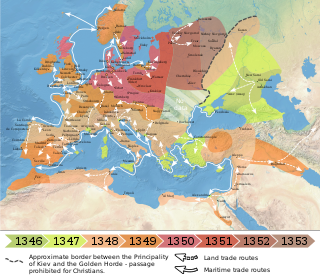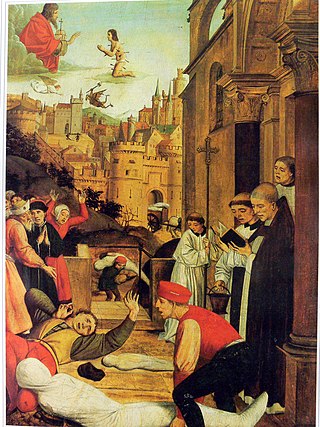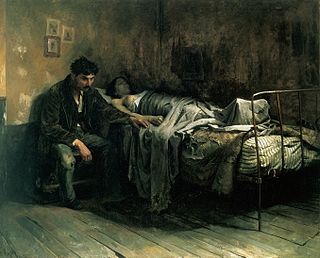Related Research Articles

The Black Death was a bubonic plague pandemic occurring in Western Eurasia and North Africa from 1346 to 1353. It is the most fatal pandemic recorded in human history, causing the deaths of 75–200 million people, peaking in Europe from 1347 to 1351. Bubonic plague is caused by the bacterium Yersinia pestis spread by fleas, but during the Black Death it probably also took a secondary form, spread by person-to-person contact via aerosols, causing pneumonic plague.

Plague is an infectious disease caused by the bacterium Yersinia pestis. Symptoms include fever, weakness and headache. Usually this begins one to seven days after exposure. There are three forms of plague, each affecting a different part of the body and causing associated symptoms. Pneumonic plague infects the lungs, causing shortness of breath, coughing and chest pain; bubonic plague affects the lymph nodes, making them swell; and septicemic plague infects the blood and can cause tissues to turn black and die.

Yersinia pestis is a gram-negative, non-motile, coccobacillus bacterium without spores that is related to both Yersinia enterocolitica and Yersinia pseudotuberculosis, the pathogen from which Y. pestis evolved and responsible for the Far East scarlet-like fever. It is a facultative anaerobic organism that can infect humans via the Oriental rat flea. It causes the disease plague, which caused the Plague of Justinian and the Black Death, the deadliest pandemic in recorded history. Plague takes three main forms: pneumonic, septicemic, and bubonic. Yersinia pestis is a parasite of its host, the rat flea, which is also a parasite of rats, hence Y. pestis is a hyperparasite.

Yersinia is a genus of bacteria in the family Yersiniaceae. Yersinia species are Gram-negative, coccobacilli bacteria, a few micrometers long and fractions of a micrometer in diameter, and are facultative anaerobes. Some members of Yersinia are pathogenic in humans; in particular, Y. pestis is the causative agent of the plague. Rodents are the natural reservoirs of Yersinia; less frequently, other mammals serve as the host. Infection may occur either through blood or in an alimentary fashion, occasionally via consumption of food products contaminated with infected urine or feces.

Mycobacterium tuberculosis, also known as Koch's bacillus, is a species of pathogenic bacteria in the family Mycobacteriaceae and the causative agent of tuberculosis. First discovered in 1882 by Robert Koch, M. tuberculosis has an unusual, waxy coating on its cell surface primarily due to the presence of mycolic acid. This coating makes the cells impervious to Gram staining, and as a result, M. tuberculosis can appear weakly Gram-positive. Acid-fast stains such as Ziehl–Neelsen, or fluorescent stains such as auramine are used instead to identify M. tuberculosis with a microscope. The physiology of M. tuberculosis is highly aerobic and requires high levels of oxygen. Primarily a pathogen of the mammalian respiratory system, it infects the lungs. The most frequently used diagnostic methods for tuberculosis are the tuberculin skin test, acid-fast stain, culture, and polymerase chain reaction.

The plague of Justinian or Justinianic plague was an epidemic that afflicted the entire Mediterranean Basin, Europe, and the Near East, severely affecting the Sasanian Empire and the Byzantine Empire and especially Constantinople. The plague is named for the Byzantine Emperor Justinian I who according to his court historian Procopius contracted the disease and recovered in 542, at the height of the epidemic which killed about a fifth of the population in the imperial capital. The contagion arrived in Roman Egypt in 541, spread around the Mediterranean Sea until 544, and persisted in Northern Europe and the Arabian Peninsula until 549. By 543, the plague had spread in every corner of the empire. As the first episode of the first plague pandemic it had profound economic, social, and political effects across Europe and the Near East and cultural and religious impact on Eastern Roman society.
Hendrik Nicholas Poinar is an evolutionary biologist specializing in ancient DNA. Poinar first became known for extracting DNA sequences from ground sloth coprolites. He is currently director of the Ancient DNA Centre at McMaster University in Hamilton, Ontario.

Paleopathology, also spelled palaeopathology, is the study of ancient diseases and injuries in organisms through the examination of fossils, mummified tissue, skeletal remains, and analysis of coprolites. Specific sources in the study of ancient human diseases may include early documents, illustrations from early books, painting and sculpture from the past. Looking at the individual roots of the word "Paleopathology" can give a basic definition of what it encompasses. "Paleo-" refers to "ancient, early, prehistoric, primitive, fossil." The suffix "-pathology" comes from the Latin pathologia meaning "study of disease." Through the analysis of the aforementioned things, information on the evolution of diseases as well as how past civilizations treated conditions are both valuable byproducts. Studies have historically focused on humans, but there is no evidence that humans are more prone to pathologies than any other animal.
Mycobacterium pinnipedii is a member of the Mycobacterium tuberculosis complex which primarily infects seals. It is a slowly growing Mycobacterium. The species is named after the Pinnipeds, the organisms from which M. pinnipedii was first isolated.

Bubonic plague is one of three types of plague caused by the bacterium Yersinia pestis. One to seven days after exposure to the bacteria, flu-like symptoms develop. These symptoms include fever, headaches, and vomiting, as well as swollen and painful lymph nodes occurring in the area closest to where the bacteria entered the skin. Acral necrosis, the dark discoloration of skin, is another symptom. Occasionally, swollen lymph nodes, known as "buboes", may break open.
Theories of the Black Death are a variety of explanations that have been advanced to explain the nature and transmission of the Black Death (1347–51). A number of epidemiologists from the 1980s to the 2000s challenged the traditional view that the Black Death was caused by plague based on the type and spread of the disease. The confirmation in 2010 and 2011 that Yersinia pestis DNA was associated with a large number of plague sites has led researchers to conclude that "Finally, plague is plague."

The history of tuberculosis encompasses the origins of the disease, tuberculosis (TB) through to the vaccines and treatments methods developed to contain and mitigate its impact.

The Black Death was a bubonic plague pandemic, which reached England in June 1348. It was the first and most severe manifestation of the second pandemic, caused by Yersinia pestis bacteria. The term Black Death was not used until the late 17th century.
The second plague pandemic was a major series of epidemics of plague that started with the Black Death, which reached medieval Europe in 1346 and killed up to half of the population of Eurasia in the next four years. It followed the first plague pandemic that began in the 6th century with the Plague of Justinian, but had ended in the 8th century. Although the plague died out in most places, it became endemic and recurred regularly. A series of major epidemics occurred in the late 17th century, and the disease recurred in some places until the late 18th century or the early 19th century. After this, a new strain of the bacterium gave rise to the third plague pandemic, which started in Asia around the mid-19th century.

Julian Parkhill is Professor of Bacterial Evolution in the Department of Veterinary Medicine at the University of Cambridge. He previously served as head of pathogen genomics at the Wellcome Sanger Institute.

Johannes Krause is a German biochemist with a research focus on historical infectious diseases and human evolution. Since 2010, he has been professor of archaeology and paleogenetics at the University of Tübingen. In 2014, Krause was named a founding co-director of the new Max Planck Institute for the Science of Human History in Jena.

Mark Achtman FRS is Professor of Bacterial Population Genetics at Warwick Medical School, part of the University of Warwick in the UK.
Globally about 600 cases of plague are reported a year. In 2017 and November 2019 the countries with the most cases include the Democratic Republic of the Congo, Madagascar, and Peru.
Ancientpathogengenomics is a scientific field related to the study of pathogen genomes recovered from ancient human, plant or animal remains. Ancient pathogens are microorganisms, now extinct, that in the past centuries caused several epidemics and deaths worldwide. Their genome, referred to as ancient DNA (aDNA), is isolated from the burial's remains of victims of the pandemics caused by these pathogens.
The Neolithic decline was a rapid collapse in populations between 5000 and 6000 years ago during the Neolithic period in western Eurasia. The specific causes of that broad population decline are still debated. While heavily populated settlements were regularly created, abandoned, and resettled during the Neolithic, after around 5400 years ago, a great number of those settlements were permanently abandoned. The population decline is associated with worsening agricultural conditions and a decrease in cereal production. Other suggested causes include the emergence of communicable diseases spread from animals living in close quarters with humans.
References
- ↑ "Molecular Palaeopathology Research Group". Max Planck Institute for Evolutionary Anthropology. Retrieved 23 Nov 2023.
- 1 2 "Dr. Kirsten Bos". Max Planck Institute for the Science of Human History. Retrieved 18 March 2019.
- ↑ "Black Death (Yersinia pestis) genomics". McMaster University Ancient DNA Centre. Retrieved 19 March 2019.
- 1 2 Minard, Anne. "Spawn of Medieval "Black Death" Bug Still Roam the Earth". National Geographic. Archived from the original on October 14, 2011. Retrieved 13 March 2019.
- ↑ "The Birth of the Black Death". The Economist. Retrieved 13 March 2019.
- 1 2 Pruitt, Sarah. "Ancient DNA Suggests Seals Brought Tuberculosis to New World". History website. Retrieved 19 March 2019.
- 1 2 Doucleff, Michaeleen. "Sea Lions And Seals Likely Spread Tuberculosis To Ancient Peruvians". NPR. Retrieved 19 March 2019.